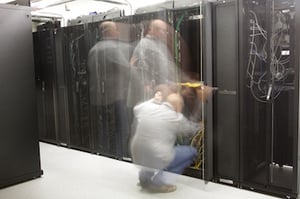Due to their sheer scale, data centers are commonly portrayed as static assets that remain in the same state for many years. This is inaccurate and can impact how an organization manages its facilities. Our new infographic imaginatively explores some of the regularly overlooked environmental conditions that occur within a data center, and the same vision can be applied to change management.
 Data centers are constantly evolving to enable the business to continue growing and as result, so do their physical footprints. Assets are transferred between loading docks to holding areas to live racks. Maintenance personnel walk miles every day. Air flows, energy is distributed and in some cases, even larger changes take place.
Data centers are constantly evolving to enable the business to continue growing and as result, so do their physical footprints. Assets are transferred between loading docks to holding areas to live racks. Maintenance personnel walk miles every day. Air flows, energy is distributed and in some cases, even larger changes take place.
One of our customers, a global financial organization with an investment portfolio of more than three quarters of a trillion dollars, illustrates one particularly complex scenario. Large scale construction projects are a major challenge for any data center operator, as is the impact on regulatory compliance, but the risks are extrapolated within a regulation-heavy sector like financial services. Operational stability becomes critical in this situation.
Connecting Assets with the Internet of Things
For our customer, temporary walls needed erecting, power and cooling required re-routing, and service availability had to be maintained throughout this disruptive process. Racks holding equipment worth hundreds of thousands of dollars in capital cost, and even greater business value, had to be securely and efficiently relocated.
The customer selected RF Code’s Workplace IoT platform because it solves these very challenges. Managing every asset and environmental change in real-time is a powerful business enabler and provides accountability and transparency for audit purposes. Asset visibility offers further practical advantages. The organization was able to implement a management strategy built around disaster avoidance and prevention, and the team were ready to react to any emerging issues immediately.
For example when CRAC (Computer Room Air Conditioning) units were taken offline, the operations department could accurately monitor the effects of the change and make proactive adjustments to the environment.
Another example was when the same customer deployed a temporary staging area. Rather than having to rely on inflexible, expensive wired infrastructure to continue monitoring assets within the new area, RF Code’s Workplace IoT instrumentation was deployed within hours without any negative affect on the business’s IT services.
This flexibility is what formed the basis of our thought leadership session at Mission Critical’s Data Center & Computing Conference. We were joined by Intel, Siemens, TSOLogic and Atos on an industry panel discussing the technologies available to corporations looking to automate facilities and enhance their data center sustainability strategies. We explained how global corporations can drive down the total cost of ownership (TCO) of their data centers, the first step towards delivering more efficient facilities and to bring operating costs under control.
The topic is covered extensively in our latest white paper. In our paper we explain how modern business leaders can leverage the Workplace IoT to enable them to optimize in the present and prepare for the future. We explore the solutions available to global enterprises that wish to extract full value from investments, prioritize activities that differentiate the company from competitors and ultimately, technologies that will assist in revenue growth.



